The Trump administration’s aggressive immigration and education policies have precipitated a dramatic decline in international student enrollment at American universities, creating a cascading economic crisis that threatens not only higher education institutions but the broader U.S. economy and its long-term competitive advantage. Between March 2024 and March 2025, international student enrollment dropped by 11.3%, representing a loss of 130,624 students and potentially $4 billion in economic activity. This decline, occurring even before the full implementation of the administration’s most restrictive policies, signals a fundamental shift that could permanently damage America’s position as the world’s premier destination for global talent and innovation.
The Scale and Scope of the Crisis
Enrollment Collapse and Economic Hemorrhaging
The magnitude of the current international student crisis extends far beyond traditional cyclical fluctuations in global mobility. According to Student and Exchange Visitor Information System (SEVIS) data, the total number of active international students fell from 1,153,169 in March 2024 to 1,022,545 in March 2025, representing an 11.33% decline that approaches the devastating 15% drop experienced during the COVID-19 pandemic. However, this current decline differs fundamentally from pandemic-related disruptions because it reflects deliberate policy choices rather than temporary health restrictions.
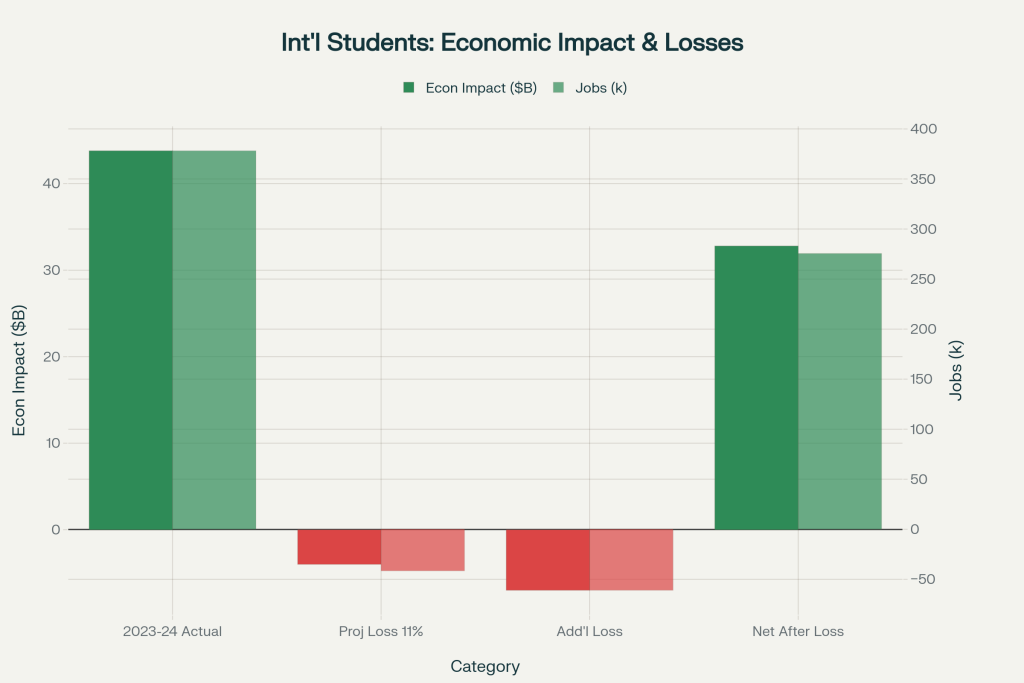
The economic ramifications are immediate and severe. International students contributed a record-breaking $43.8 billion to the U.S. economy during the 2023-24 academic year, supporting 378,175 jobs across diverse sectors including housing, food service, retail, transportation, and insurance. The current enrollment decline translates to an estimated $4 billion reduction in economic activity, while experts project potential losses of up to $7 billion if anticipated 30-40% enrollment declines materialize.
These figures represent more than abstract economic data—they reflect tangible impacts on communities nationwide. California, hosting nearly 141,000 international students, generated $6.4 billion in economic activity, while New York’s 135,000 international students contributed $6.3 billion. Even smaller states experience significant benefits: Iowa’s 8,515 international students contribute $217.9 million annually, supporting 1,858 jobs.
International Student Enrollment Crisis
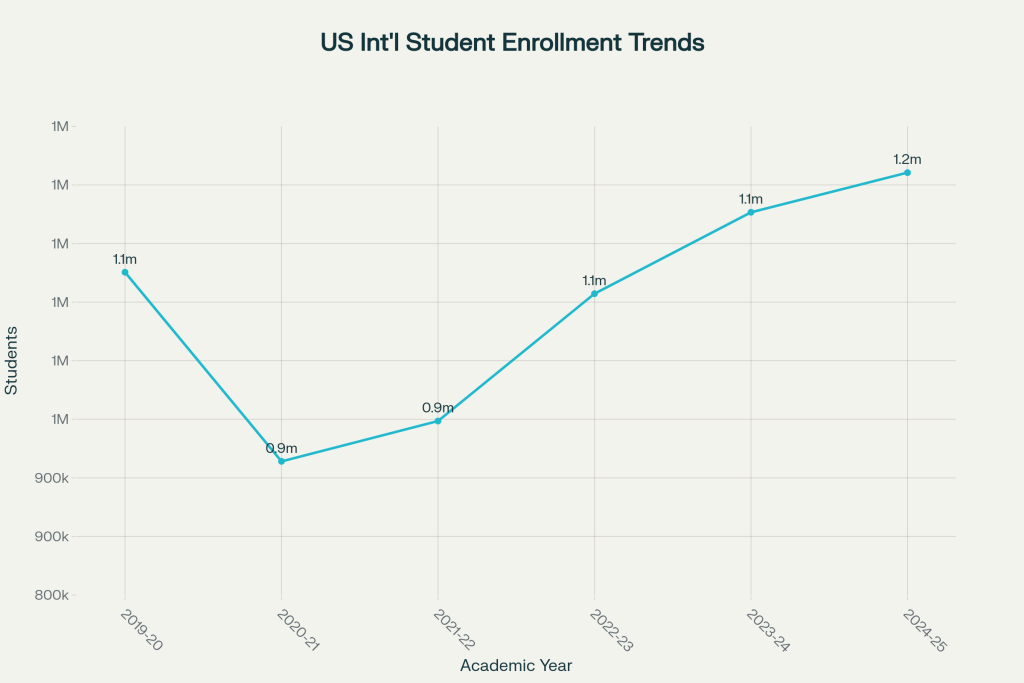
The enrollment trend data shows a concerning pattern: while total international student numbers have recovered to record highs of 1.16 million students in 2024-25, new international student enrollment has declined by 5% for the first time since the pandemic recovery. This decline in new students signals future enrollment drops as current students graduate without sufficient replacement.
Economic Impact by State
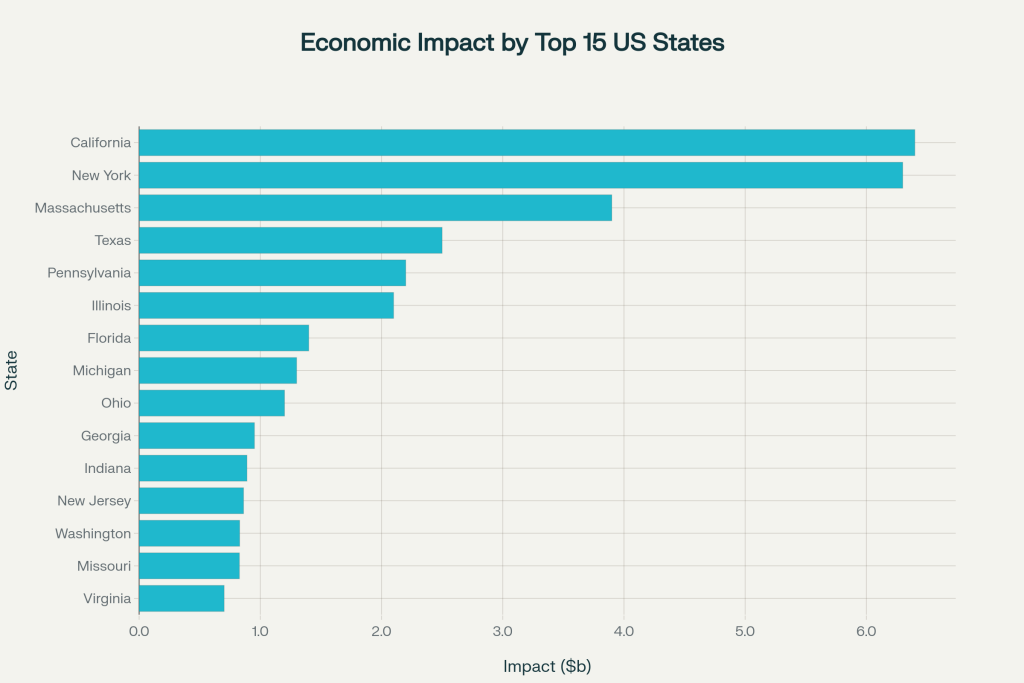
The state-level economic impact analysis reveals the massive financial stakes involved. California and New York each receive over $6 billion annually from international students, while states like Massachusetts ($3.9 billion), Texas ($2.5 billion), and Pennsylvania ($2.2 billion) also face substantial potential losses. These figures represent not just university revenue but broader economic activity supporting hundreds of thousands of jobs in local communities.
Shifting Country Demographics

The country-wise enrollment data shows a dramatic shift in international student origins. India overtook China as the top sender country in 2023-24, with 331,602 Indian students (+35%) compared to 277,398 Chinese students (-4%). However, Trump administration policies specifically targeting Chinese students and implementing travel bans threaten to disrupt these patterns further.
Federal Research Funding Catastrophe
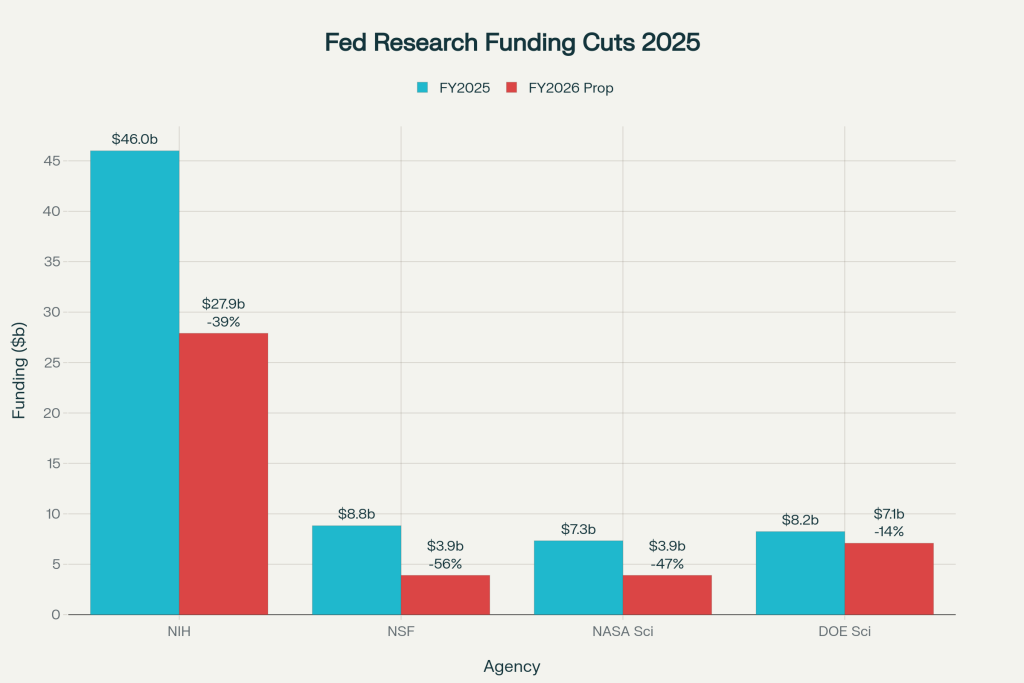
The federal research funding cuts represent an unprecedented assault on university research infrastructure. The Trump administration has proposed devastating cuts for FY2026: NIH funding would drop 39% to $27.9 billion, while NSF would be slashed 56% to $3.9 billion. These cuts directly threaten the financial support system for international graduate students, who comprise a significant portion of research assistants in STEM fields.
University Financial Crisis
| University | Budget Deficit/Issue | Layoffs/Cuts | Primary Causes | Enrollment Impact |
|---|---|---|---|---|
| Temple University | $60 million structural deficit | 5% compensation cuts, position eliminations | Enrollment decline, state funding | 10,000 student decline since 2017 |
| Cornell University | Profound financial challenges | Layoffs under consideration | Federal research cuts, policy uncertainty | International student concerns |
| Northwestern University | Federal funding freeze (~$800M) | 425 positions eliminated (5% of staff) | Federal funding freeze, research cuts | International student restrictions |
| University of Connecticut | $134 million budget gap | Workforce cuts, hiring restrictions | State appropriation cuts, research funding down | Multiple pressures |
| University of Wisconsin-Madison | 5-7% budget cuts required | 5% college cuts, 7% admin cuts | Federal grant risks, int’l student uncertainty | International student visa issues |
| University of Oregon | $25.7 million deficit | 42 employees (including 11 faculty) | Federal/state actions, labor costs | Enrollment challenges |
| Columbia College Chicago | ~$40 million deficit | 20 full-time faculty (18 tenured) | Enrollment collapse (12K to 5.5K students) | Severe enrollment decline |
| Clark University | Nearly $3 million shortfall | Up to 30% faculty, 5% staff cuts | Missing enrollment targets | 80-100 students below target |
| University of Minnesota | Hundreds of positions cut | Hundreds of positions | Federal policy impacts | Policy-related concerns |
| Harvard University | Federal funding targeted | Legal challenges ongoing | Trump administration targeting | International student ban attempts |
| Stanford University | Federal funding impacts | Budget adjustments | Research funding uncertainty | Research student impacts |
| Western Washington University | $23 million deficit | 20 positions eliminated | Budget deficit growth | Multiple factors |
| Southern New Hampshire University | Cost reduction measures | 60 jobs across 8 departments | Operational efficiency | Not specified |
The comprehensive table of university budget crises demonstrates the widespread nature of the financial emergency facing American higher education. From Temple University’s $60 million structural deficit to Northwestern’s elimination of 425 positions, institutions across the spectrum are implementing dramatic cost-cutting measures. The crisis affects both elite research universities and smaller regional institutions.
Travel Ban Impact
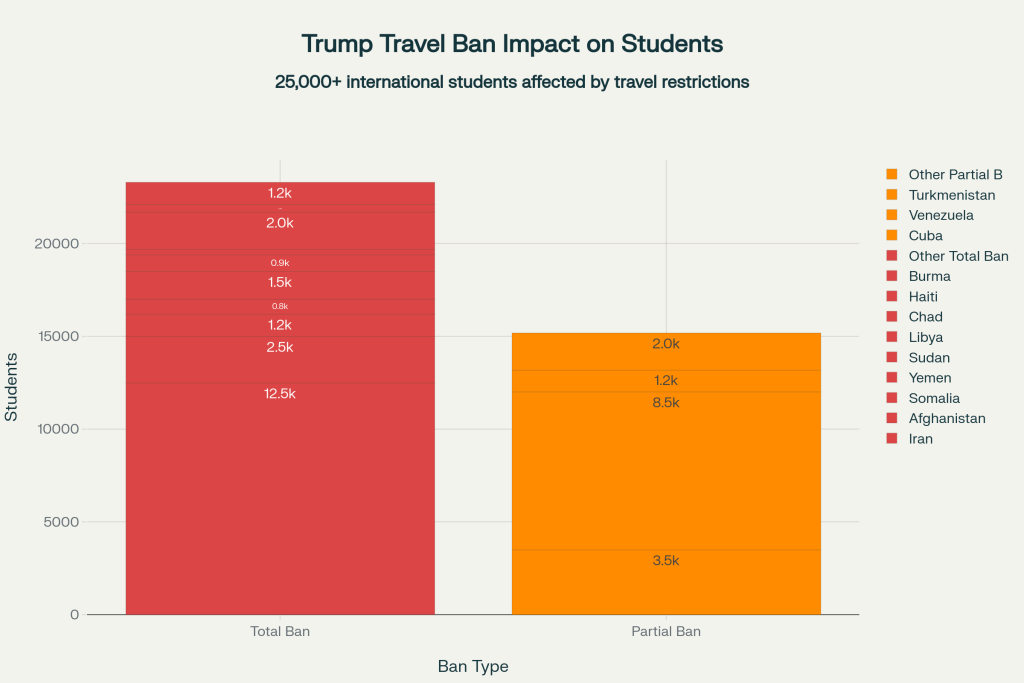
The Trump administration’s expanded travel ban affects over 25,000 current international students from 19 countries, with Iran alone contributing 12,490 students to U.S. institutions. The ban represents both immediate disruption for current students and long-term damage to America’s reputation as a welcoming destination for global talent.
Global Competition Intensifies
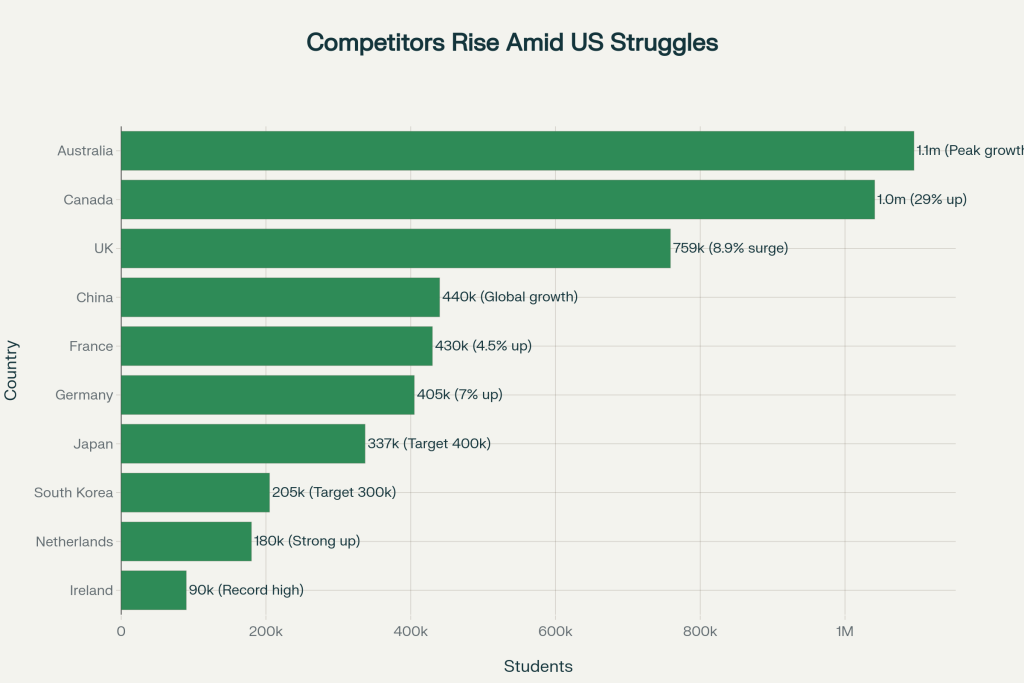
While the U.S. struggles with restrictive policies, competitor countries are aggressively expanding their international education sectors. Australia hosts 1.095 million international students with “highest growth since 2019,” while Canada welcomed over 1 million students (29% increase) before implementing its own caps. Germany expects 405,000 students with 90% of universities reporting growth, and the UK saw an 8.9% surge in Chinese applications.
Projected Economic Devastation
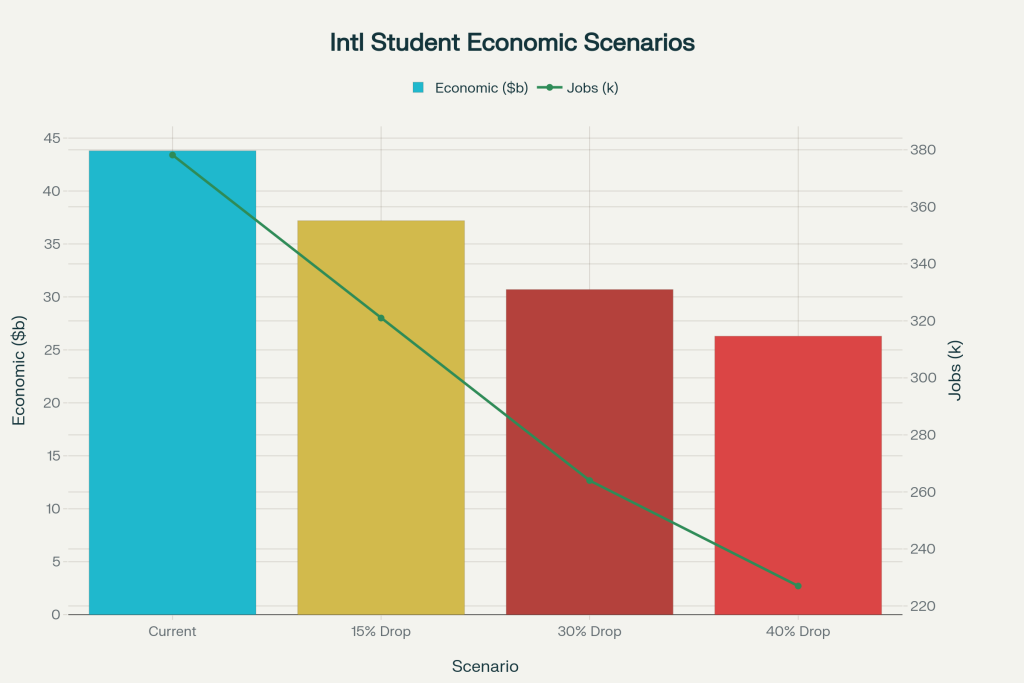
Economic modeling shows the potential scale of losses from continued enrollment declines. NAFSA projects that a 30-40% drop in new international student enrollment could result in $7 billion in lost economic activity and over 60,000 fewer jobs. In the worst-case scenario, the U.S. economy could lose $17.5 billion and 151,000 jobs if current policy trends continue.
Additional Supporting Data and Trends
Visa Processing Delays and Restrictions
The Trump administration suspended student visa interview appointments for three weeks during peak processing season (May 27 – June 18, 2025), implementing enhanced social media screening requirements. F-1 visa issuance dropped 12% from January-April 2025 and 22% in May 2025 compared to 2024 levels. Limited appointment availability persists at key consulates in India, China, Nigeria, and Japan.
Research Grant Terminations
Federal agencies have terminated thousands of research grants. Grant Watch tallied over 2,482 terminated NIH grants worth $8.7 billion and 1,669 terminated NSF grants worth $1.5 billion as of mid-June 2025. Many additional grants have been flagged for review based on keywords related to diversity, equity, and inclusion research.
International Interest Declining
Real-time data from Studyportals shows that international student interest in studying in the United States collapsed by 50% between January and April 2025. Even American students are losing confidence, with domestic student interest in U.S. degrees dropping 20.5% in Q1 2025 while interest in Ireland, Switzerland, and other alternatives surged.
Disproportionate Impact on Graduate Programs and STEM Fields
The enrollment decline has been particularly acute in graduate programs, which experienced a 20.52% decrease overall, with master’s programs losing 106,158 students. This trend is especially concerning given that 83% of all doctorate degrees earned by temporary visa holders are in science and engineering fields, with 71% of these graduates remaining in the U.S. after five years. The loss of this talent pipeline threatens America’s technological leadership in critical areas including artificial intelligence, where 70% of full-time graduate students are international.
Indian students, traditionally a cornerstone of American graduate education, experienced the most dramatic decline at 27.90% (-98,853 students), while Chinese student numbers increased by 3.28% (+8,364), returning China to its historical position as the top sender country. This shift reflects not only changing geopolitical dynamics but also the effectiveness of targeted policies in reshaping international student flows.
Trump Administration Policies: A Systematic Assault on International Education
Travel Bans and Visa Restrictions
The Trump administration has implemented an unprecedented array of policies specifically targeting international students and the institutions that host them. The June 2025 travel ban expanded restrictions to 19 countries, fully suspending visa issuance to nationals from Afghanistan, Burma, Chad, Republic of the Congo, Equatorial Guinea, Eritrea, Haiti, Iran, Libya, Somalia, Sudan, and Yemen, while partially restricting visas for students from Burundi, Cuba, Laos, Sierra Leone, Togo, Turkmenistan, and Venezuela.
The administration has also revoked over 1,000 student visas, often without explanation, creating an atmosphere of uncertainty that extends far beyond those directly affected. The May 2025 suspension of student visa interviews during peak processing season further disrupted the traditional application cycle, while new social media screening requirements have added bureaucratic barriers and privacy concerns.
Federal Research Funding Decimation
Perhaps even more damaging than visa restrictions are the massive cuts to federal research funding that support international graduate students. The National Institutes of Health (NIH) and National Science Foundation (NSF) have experienced devastating reductions, with NIH awards down 29% and NSF awards dropping 50% in 2025 compared to recent years. The proposed FY2026 budget calls for a 39% cut to NIH funding and a 56% reduction for NSF.
These cuts directly threaten the financial foundation supporting international graduate students, who rely heavily on research assistantships funded by federal grants. Approximately 69% of federally supported students receive research assistantships funded by federal grants, with the potential impact affecting between 50,000 and 77,000 international STEM graduate students—roughly 10% of the total international STEM graduate population.
Institutional Targeting and Regulatory Pressure
The administration has also pursued targeted attacks against specific institutions, most notably attempting to ban international students from Harvard University—a move temporarily blocked by federal courts. This unprecedented action signals the administration’s willingness to use immigration policy as a weapon against institutions it deems ideologically problematic, creating uncertainty throughout the higher education sector.
University Financial Crisis and Operational Impacts
Budget Deficits and Layoffs
The combination of declining international enrollment and reduced federal funding has created a perfect storm of financial pressure for American universities. Major research institutions are announcing significant budget cuts and layoffs with increasing frequency. Temple University projects a $60 million budget deficit, Cornell University faces “profound financial challenges,” and the University of Minnesota is eliminating hundreds of positions while raising undergraduate tuition by up to 7.5%.
The crisis extends beyond elite institutions to affect universities across the spectrum. West Virginia University eliminated 28 majors and 169 faculty positions in 2023, while Sonoma State University faces potential cuts to 22 majors and more than 100 faculty positions. Columbia College Chicago laid off 20 full-time faculty members, including 18 tenured professors, as enrollment collapsed from over 12,000 students to 5,570.
Revenue Dependency and Vulnerability
Public universities have become particularly vulnerable due to their increasing reliance on international students to subsidize domestic education costs. International students at Arizona State University pay approximately $37,000 annually compared to $15,000 for in-state students. At many institutions, international students account for 12% of total tuition revenue, with some universities reporting that over 30% of their tuition income comes from international students.
This revenue model, developed over decades as state funding declined, now represents a critical vulnerability. Research demonstrates that a 10% drop in state appropriations induced a 16% increase in foreign enrollment at public research universities, highlighting the sector’s financial dependence on international students. With both state funding remaining flat and international enrollment declining, universities face an unprecedented fiscal crisis.
Regional Economic Disruption
The impact extends far beyond university campuses to surrounding communities. University towns depend heavily on international students for housing, dining, retail, and service sectors. Local housing markets, restaurants, and entertainment venues face reduced demand as international student populations decline. The multiplier effect means that each international student supports multiple jobs in the broader economy, making entire regions vulnerable to enrollment declines.
Global Competition and America’s Declining Advantage
Competitor Countries Capitalizing on U.S. Losses
While American universities struggle with declining international enrollment, competitor countries are aggressively positioning themselves to capture displaced students. Germany expects to welcome 405,000 international students in 2025, representing a 7% increase, with 90% of German universities reporting rising international enrollments and a 56% increase in master’s program enrollment.
The United Kingdom has experienced an 8.9% surge in Chinese applications since January 2025, with institutions like University College London—where Chinese student tuition accounts for 10% of revenues—actively recruiting students deterred by U.S. policies. European universities are offering more accessible work permits, lower tuition fees, and clearer pathways to permanent residency, making them increasingly attractive alternatives to American institutions.
China’s Strategic Advantage
China’s emergence as both a competitor for international students and a destination for U.S.-trained talent represents a particularly serious challenge. China now attracts over 440,000 international students annually, ranking third globally behind the U.S. and U.K.. More concerning, China is successfully attracting students from the Global South, with African student enrollment growing from 2,200 in 2003 to 82,000 in 2018.
The loss of talent to China extends beyond student recruitment. A notable example involves a Turkish international student who, unable to remain in the U.S. after graduation, took his ideas to China, enabling Huawei’s leadership in 5G technology and contributing to China’s acquisition of 10 times more patents than its closest competitor. This brain drain represents not only lost innovation but active contribution to strategic competitors.
Declining Search Interest and Future Implications
Real-time data from Studyportals reveals that international student interest in studying in the United States has collapsed by 50% between January and April 2025, falling to levels not seen since the height of the COVID-19 pandemic. Weekly pageviews for U.S. degree programs have declined dramatically, while students increasingly explore alternatives in the U.K., Spain, Ireland, Australia, Germany, New Zealand, and Switzerland.
Particularly concerning is the fact that American students themselves are losing confidence in U.S. higher education, with domestic student interest in U.S. degrees dropping 20.5% in Q1 2025. American students are increasingly looking to Ireland (63% increase), Switzerland, Sweden, and Spain (25-30% increases) for educational opportunities.
Long-term Economic and Strategic Implications
Innovation and Entrepreneurship Losses
The decline in international students threatens America’s innovation ecosystem in fundamental ways. Foreign-born individuals founded or co-founded 44% of U.S. “unicorn” startup companies valued at $1 billion or more, with 25% founded by former international students. The technology enabling platforms like Zoom and FaceTime was invented by an international student, while 42% of the founders of top AI companies studied in the United States as international students.
International students and graduates comprise nearly 60% of doctorate-level computer and mathematical scientists (58%) and doctorate-level engineers (56%) employed in the U.S.. Their contribution extends beyond individual achievement to systemic innovation capacity—research shows that each foreign-born STEM worker contributes between $12,225 to $13,568 to U.S. GDP annually while still in training, with the post-graduate STEM workforce collectively contributing up to $409 billion in labor value-added, representing 1.9% of U.S. GDP.
STEM Workforce Crisis
The United States already faces a projected shortage of 1.4 million STEM workers by 2030. International students fill critical gaps in this workforce, with foreign-born workers comprising approximately 19% of the overall U.S. STEM workforce and dramatically higher percentages in advanced degree positions. The stay rates for temporary visa holders with doctorate science and engineering degrees are approximately 71% after five years and 65% after ten years, with the highest rates in fields crucial for national security and economic competitiveness.
The current policies risk exacerbating these shortages at precisely the moment when global competition in technology sectors is intensifying. China’s research spending is expected to grow by 10% in 2025 alone, while the U.S. faces significant reductions in federal research funding. This combination of reduced talent attraction and decreased research investment threatens America’s longstanding technological leadership.
Economic Competitiveness and Trade Impact
International education represents one of America’s most successful service exports, contributing to a positive trade balance in services even as the U.S. runs trade deficits in goods. The decline in international students threatens this comparative advantage while simultaneously strengthening competitors who are actively recruiting the same talent pool.
The broader economic implications extend to regional development patterns, innovation clusters, and industrial competitiveness. States with high concentrations of research universities have built economic ecosystems around international talent, creating multiplier effects that extend far beyond individual institutions. The disruption of these patterns could have lasting effects on regional economic development and national competitive positioning.
Sectoral and Regional Analysis
State-Level Vulnerabilities
The impact of declining international enrollment varies significantly across states, reflecting different levels of dependence on international students and varying institutional profiles. California, while hosting the largest absolute number of international students (237,763), experienced relatively modest declines (-2.27%) due to its diverse international student population. In contrast, Texas saw a 16.48% decline (15,064 students), while Michigan (-15.48%), Illinois (-15.03%), Ohio (-12.80%), and Florida (-10.03%) experienced substantial losses.
Some smaller states have actually benefited from redistribution effects, with Wyoming (+8.7%), Vermont (+6.2%), New Hampshire (+4.9%), Maine (+4.3%), and Montana (+3.8%) experiencing increases. These gains reflect strategic positioning by institutions in safer, lower-cost locations, but the absolute numbers remain small compared to losses in major destination states.
Community College and Language Program Impacts
The crisis extends beyond four-year institutions to affect community colleges and English language programs. California hosts 13,989 international students in community colleges, contributing $591.1 million to the economy and supporting 2,534 jobs. Texas community colleges enroll 11,676 international students contributing $327.8 million and generating 1,403 jobs.
English language programs, often overlooked in policy discussions, support 9,782 international students who contribute $371.3 million and create 2,691 jobs nationwide. These programs serve as crucial entry points for international students and contribute significantly to local economies, particularly in smaller communities.
Industry and Labor Market Effects
The decline affects multiple economic sectors beyond higher education. The hospitality, retail, transportation, and service industries in university towns face reduced demand as international student populations shrink. Real estate markets experience decreased rental demand, while restaurants, entertainment venues, and other consumer-focused businesses see declining customer bases.
The long-term labor market implications are equally serious. Industries dependent on highly skilled workers—including technology, pharmaceuticals, engineering, and advanced manufacturing—face potential talent shortages as the pipeline of international graduates diminishes. This is particularly problematic given that many domestic students avoid STEM fields, creating structural labor market imbalances that could persist for years.
Policy Responses and Institutional Adaptations
University Strategies and Diversification Efforts
Universities are implementing various strategies to address the crisis, though options remain limited given the scale of federal policy changes. Some institutions are diversifying recruitment efforts toward countries less affected by travel restrictions, while others are developing online and hybrid programs to maintain international engagement despite visa limitations.
Canadian universities report that 100% of institutions consider it “possible” or “very likely” that they will diversify into new markets, including increasing recruitment of American students concerned about domestic political developments. This represents a complete reversal of traditional North American student mobility patterns.
State and Local Responses
Some states and localities are attempting to counteract federal policies through welcoming initiatives and support programs for international students. However, immigration policy remains primarily a federal responsibility, limiting the effectiveness of state-level interventions.
Educational organizations, including NAFSA and the American Council on Education, have mobilized advocacy efforts and legal challenges, though the administration’s broad authority over immigration policy limits the scope for successful judicial intervention.
International Perspectives and Comparative Analysis
European Models and Strategies
European countries are successfully implementing policies that contrast sharply with U.S. restrictions. Germany’s Skilled Immigration Act allows international students to work longer hours while studying and facilitates smoother transitions to permanent residency. France has expanded student integration programs, including free French language courses and subsidized housing, leading to a 5% increase in international enrollments.
Finland has reformed its residency pathways to accommodate students’ families, while maintaining competitive tuition rates and high-quality English-taught programs. These policies demonstrate alternative approaches that balance national interests with global talent attraction.
Asian Competition and Opportunities
Asian countries are also positioning themselves as alternatives to U.S. higher education. Japan aims to increase its foreign student population to 400,000 over the next decade, up from approximately 337,000 currently. Malaysia, Singapore, and South Korea are expanding English-taught programs and developing research partnerships that compete directly with U.S. institutions.
China’s dual role as both competitor and partner creates complex dynamics. While Chinese students represent a significant portion of international enrollment in the U.S., China is simultaneously developing its higher education capacity and attracting international students, particularly from developing countries.
Recommendations and Future Outlook
Policy Reform Imperatives
The current trajectory is unsustainable if the United States wishes to maintain its position as a global leader in higher education and innovation. Policy reforms should focus on creating predictable, welcoming pathways for international students while addressing legitimate security concerns through targeted rather than broad-based restrictions.
Restoration of federal research funding to competitive levels is essential for maintaining America’s research infrastructure and supporting the international graduate students who comprise a crucial component of the scientific workforce. The current funding cuts threaten not only immediate research projects but the long-term capacity of American universities to compete globally.
Institutional Strategies
Universities must develop more resilient financial models that reduce over-dependence on any single revenue source while maintaining international engagement. This may require fundamental restructuring of operations, program offerings, and pricing strategies.
Collaboration between institutions, states, and federal agencies could help develop comprehensive approaches to international student recruitment and retention that serve both educational and economic interests. Regional consortiums might provide economies of scale and shared risk management that individual institutions cannot achieve independently.
Economic Recovery Scenarios
The speed and extent of recovery will depend largely on policy changes at the federal level. If current restrictions continue or expand, the United States may experience permanent market share losses to competitor countries that could take decades to recover. Historical precedents suggest that reputation damage in international education markets can persist long after policy changes occur.
Alternatively, policy reversals combined with proactive recruitment efforts could potentially restore some losses, though the competitive landscape has fundamentally changed with other countries now offering more attractive alternatives than existed previously.
Conclusion
The Trump administration’s policies targeting international students represent more than isolated immigration restrictions—they constitute a systematic undermining of one of America’s most successful economic and soft power assets. The $43.8 billion economic contribution and 378,175 jobs supported by international students represent tangible benefits that extend throughout American communities, from major metropolitan areas to small college towns.
The current crisis occurs at a critical juncture in global competition for talent and technological leadership. While the United States implements increasingly restrictive policies, competitor countries are developing more welcoming frameworks that capitalize on American policy failures. The result is not merely a temporary enrollment decline but a fundamental shift in global higher education patterns that could permanently disadvantage American institutions and the broader economy.
The implications extend far beyond university budgets to encompass national competitiveness, innovation capacity, and economic security. The United States faces a choice between continuing down a path of educational isolationism that strengthens competitors and weakens domestic capacity, or recognizing international students as the strategic asset they represent and developing policies that support rather than undermine this crucial resource.
The window for corrective action is narrowing as international students and their families make decisions about educational destinations that will shape global talent flows for years to come. The economic and strategic costs of current policies are already substantial and growing, while the benefits of international student engagement—economic, educational, and diplomatic—remain as compelling as ever. The question is whether American policymakers will recognize these realities before irreversible damage occurs to one of the nation’s most valuable competitive advantages.
The evidence is clear: international students are not a burden to be managed but a resource to be cultivated. Their contributions to American universities, communities, and the broader economy justify policies that welcome rather than restrict their participation in American higher education. The alternative—a continued exodus of global talent to competitor countries—represents an unforced error of historic proportions that will weaken America’s position in the global knowledge economy for generations to come.




